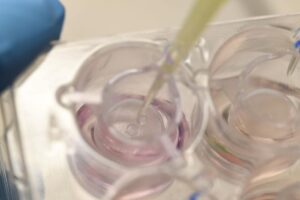SAPs4Tissue launched – human tissue models with customized biomaterials

Synthesis of specific peptides that form nanofibrils.
(c) Carsten Costard / Max Planck Institute for Polymer Research
Human tissue models instead of animal experiments? What is already possible for some questions still faces major hurdles for more complex contexts and applications.
In a joint project of the Max Planck Institute for Polymer Research, Mainz, and the Translational Center for Regenerative Therapies at the Fraunhofer Institute for Silicate Research ISC, Würzburg, scientific principles and biomaterials for the standardized production of valid tissue models are to be developed.
Modern medicine increasingly relies on three-dimensional human tissue models in preclinical drug development. These represent an ethically unproblematic and often scientifically more meaningful alternative to animal testing. However, an important prerequisite for safe use in risk and efficacy testing of drugs is that these model systems are as close as possible to human tissue in terms of morphology and functionality.

Credit: K. Selsam / Fraunhofer Translational Center Regenerative Therapies/Fraunhofer ISC
This is precisely where the SAPs4Tissue project comes in: with the help of ordered molecular protein building blocks, the so-called peptide nanofibrils (SAPs), physiological environmental conditions of the cell are simulated in combination with biological polymers. Human cells see, so to speak, their “natural environment”, the so-called extracellular matrix, a soft biopolymer matrix surrounding them. In addition, the molecular building blocks are provided with chemical groups that allow the material properties to be specifically influenced with the aid of external signals, such as light or the pH value. The researchers hope to use this resulting scaffold structure to transform human stem cells into specialized cells and grow them as functional tissues such as the intestine. This is possible through methods known as “tissue engineering,” an interdisciplinary field of work that applies principles from engineering and life science for targeted tissue cultivation. The project will also systematically investigate the relationships between molecular signature, three-dimensional structure and tissue-specific function.
The project leaders, Dr. Christopher Synatschke, Dr. Tanja Weil (MPI Polymer Research), Dr. Marco Metzger and Dr. Daniela Zdzieblo (Fraunhofer ISC) are confident: “Bringing together the core competencies of biomaterials, stem cell biology and tissue engineering will produce a completely new class of scaffolds that will allow the standardized construction of different human tissues.” Success of the work would not only further boost basic research in the field of tissue and disease development, but would also have significant socio-economic relevance through the replacement of animal testing and through more effective preclinical testing methods, which would have a direct positive impact on the costs for the healthcare system.
Infobox
The SAPs4Tissue project is funded by the Fraunhofer-Gesellschaft and the
Max Planck Society.
Wissenschaftliche Ansprechpartner:
Dr. habil. Marco Metzger l Phone +49 931 31-86686 l marco.metzger@isc.fraunhofer.de | Fraunhofer Translational Center for Regenerative Therapies TLZ-RT, Würzburg l www.tlz.fraunhofer.de
Dr. Christopher Synatschke l Phone +49 6131 379-260 l synatschke@mpip-mainz.mpg.de| Max Planck Institute for Polymer Research, Mainz l www.mpip-mainz.mpg.de
Dr. Daniela Zdzieblo l Phone +49 931 31-82164 l daniel.zdzieblo@isc.fraunhofer.de | Fraunhofer Translational Center for Regenerative Therapies TLZ-RT, Würzburg l www.tlz.fraunhofer.de
Weitere Informationen:
https://www.regenerative-therapien.fraunhofer.de/en/fields-of-activity/in-vitro-… More about In-vitro test systems
https://www.mpip-mainz.mpg.de/en/weil/projects/saps4tissue More information about the project
Media Contact
All latest news from the category: Life Sciences and Chemistry
Articles and reports from the Life Sciences and chemistry area deal with applied and basic research into modern biology, chemistry and human medicine.
Valuable information can be found on a range of life sciences fields including bacteriology, biochemistry, bionics, bioinformatics, biophysics, biotechnology, genetics, geobotany, human biology, marine biology, microbiology, molecular biology, cellular biology, zoology, bioinorganic chemistry, microchemistry and environmental chemistry.
Newest articles

Innovative 3D printed scaffolds offer new hope for bone healing
Researchers at the Institute for Bioengineering of Catalonia have developed novel 3D printed PLA-CaP scaffolds that promote blood vessel formation, ensuring better healing and regeneration of bone tissue. Bone is…

The surprising role of gut infection in Alzheimer’s disease
ASU- and Banner Alzheimer’s Institute-led study implicates link between a common virus and the disease, which travels from the gut to the brain and may be a target for antiviral…

Molecular gardening: New enzymes discovered for protein modification pruning
How deubiquitinases USP53 and USP54 cleave long polyubiquitin chains and how the former is linked to liver disease in children. Deubiquitinases (DUBs) are enzymes used by cells to trim protein…



